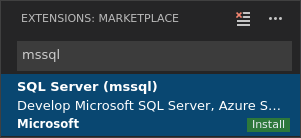mssql extension for Visual Studio Code
Applies to:
SQL Server
Azure SQL Database
Azure SQL Managed Instance
Azure Synapse Analytics
SQL database in Microsoft Fabric
This article introduces the mssql extension for Visual Studio Code (VS Code) to work with databases in SQL Server on Windows, macOS, and Linux, as well as Azure SQL Database and Azure SQL Managed Instance. The mssql extension for Visual Studio Code provides querying capabilities for Azure SQL and SQL Server as well as additional features for developers with SQL Projects and SQL bindings for Azure Functions. The mssql extension for VS Code includes the SQL Database Projects extension.
Functionality overview
The following functionality is available in the mssql extension for VS Code:
- Connect to Microsoft SQL Server, Azure SQL Database, Azure SQL Managed Instance and Azure Synapse Analytics dedicated SQL pools.
- Create and manage connection profiles and most-recently used connections.
- Write T-SQL script with IntelliSense, Go to Definition, T-SQL snippets, syntax colorizations, T-SQL error validations and GO batch separator.
- Execute your scripts and view results in a simple-to-use grid.
- Access executed query history.
- Save results to json or csv file format and view in the editor.
- Customizable extension options including command shortcuts and more.
- Create Azure Functions with SQL binding.
Compare Azure Data Studio and the mssql extension
Both Azure Data Studio and the mssql extension for VS Code are available for Windows, macOS, and Linux.
Benefits of working with Azure SQL and SQL Server in VS Code include:
- Single code editor for your SQL and other code (such as C#, Python, JavaScript, Java, PHP, and Go).
- Broad extension marketplace with extensions for remote development, containers, and more.
- Available for use in GitHub Codespaces.
You might consider using Azure Data Studio in addition to the mssql extension for VS Code if you would benefit from these capabilities:
- Quickly create charts and visualize result sets
- Graphical table designer and query plans.
- Schema comparison for databases, SQL projects, and dacpacs.
- Extensions for SQL Agent, SQL Profiler, and Flat File Import.
- SQL and .NET Interactive notebooks.
Getting started with the mssql extension in VS Code
Install the mssql extension
To install the mssql extension in VS Code, follow these steps:
Download and install Visual Studio Code on your machine.
In Visual Studio Code, select View > Command Palette, or press Ctrl+Shift+P, or press F1 to open the Command Palette.
In the Command Palette, select Extensions: Install Extensions from the dropdown.
In the Extensions pane, type mssql.
Select the SQL Server (mssql) extension, and then select Install.

After the installation completes, select Reload to enable the extension.
Connect and query
To connect to a SQL instance and query a database, follow these steps:
In the SQL Server pane, select Add Connection connection icon (plus sign) from the Connections viewlet.
Follow the prompts to specify the properties for the new connection profile. After specifying each value, press Enter to continue.
Connection property Description Server name or ADO connection string Specify the SQL Server instance name. Use localhost to connect to a SQL Server instance on your local machine. To connect to a remote SQL Server, enter the name of the target SQL Server, or its IP address. To connect to a SQL Server container, specify the IP address of the container's host machine. If you need to specify a port, use a comma to separate it from the name. For example, for a server listening on port 1401, enter <servername or IP>,1401.
By default, the connection string uses port 1433. A default instance of SQL Server uses 1433 unless modified. If your instance is listening on 1433, you do not need to specify the port.
As an alternative, you can enter the ADO connection string for your database here.Database name (optional) The database that you want to use. To connect to the default database, don't specify a database name here. Authentication Type Choose either Integrated or SQL Login. User name If you selected SQL Login, enter the name of a user with access to a database on the server. Password Enter the password for the specified user. Save Password Press Enter to select Yes and save the password. Select No to be prompted for the password each time the connection profile is used. Profile Name (optional) Type a name for the connection profile, such as localhost profile. After you enter all values and select Enter, Visual Studio Code creates the connection profile and connects to the SQL Server.
If an initial connection attempt fails with encryption enabled (default), the mssql extension will provide a notification prompt with an option to attempt the connection with Trust Server Certificate enabled. More information about this option is available in the connection tutorial.
Supported operating systems
The mssql extension for VS Code is supported on Windows, macOS, and Linux. The following versions are supported:
- Windows: 7 (with SP1), 8, 8.1, 10, 11
- Windows Server: 2016, 2019, 2022
- macOS: 10.12+, 11, 12
- Linux: Debian 9+, RHEL 7+, Ubuntu 18.04+
SQL Tools Service
The mssql extension automatically installs the SQL Tools Service, an open source .NET-based API that provides services to several SQL tools, including Azure Data Studio and the mssql extension for VS Code. The SQL Tools Service provides features such as common language service operations (IntelliSense auto-complete suggestions, peek definition, SQL error diagnostics, quickinfo hovers), connection management, and query execution. The source code for SQL Tools Service is available on GitHub.